|
Co-sponsors of the 2023 Winning Out
Certificates


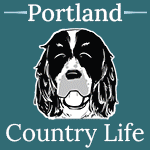
| |
Play your way to agility success...
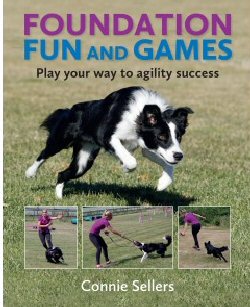 Wing work is a hugely important part of foundation training
as it teaches dogs to turn tightly. The ability to decelerate, bend around a
wing, and then accelerate to the next obstacle allows for fast, fluid movement
which will save precious time on an agility course. In an exclusive extract,
Connie Sellers, author of Foundation Fun & Games, focuses on wing wraps
and associated handling moves. Wing work is a hugely important part of foundation training
as it teaches dogs to turn tightly. The ability to decelerate, bend around a
wing, and then accelerate to the next obstacle allows for fast, fluid movement
which will save precious time on an agility course. In an exclusive extract,
Connie Sellers, author of Foundation Fun & Games, focuses on wing wraps
and associated handling moves.
Long before you start tackling equipment or running courses, you can take the
vital first steps to launch your dog’s agility career. If you get it right from
day one, shaping his mental attitude and honing his skills, you could be
nurturing the star of tomorrow.
The temptation is to practise wing wraps on jumps at low height, as this
appears to be low impact in terms of physical demands on a young puppy. But this
involves two different skills – turning and jumping – so in terms of physical
impact, and mental pressure, it is best to focus on wing work as a separate
skill before introducing the element of jumping.
As a guideline, wing work can be introduced on an occasional basis when a pup
is around 8-10 months of age and increased gradually as he matures. The
combination of jumping and wing wrapping should be introduced from around 14
months.
Getting started
To teach wings wraps you can use a jump wing, a barrel a cone, or any other
object your dog can wrap around. In the following games, I will refer to jump
wings. For safety’s sake, make sure you remove jump cups before using the wings.
When I start training wraps, I use treats which allows for better control and
understanding, and then move on to using a toy as a reward when learning is
established.
Introducing the obstacle
When I introduce wing work, I start with a front cross and use a mixture of
luring and shaping.2
 How
to play How
to play
The handler starts with the dog on the left hand-side, standing in front
of the jump wing.
The handler waits for the dog to offer a move in the direction of the
wing.
If the dog takes a step towards the wing, the handler rewards him by
dropping a treat (from the right hand) on the right side of the wing, which
encourages him to move in a clockwise direction around the wing.
Work on this, with the handler dropping treats further round the jump
wing until the dog is confidently wrapping around it. At this stage the
handler can introduce a verbal cue, such as "check".
Repeat, with the dog on the right side, wrapping round the wing in an
anti-clockwise direction. You can use the same verbal cue – "check" – as the
dog is still wrapping round a wing, or you may prefer to introduce a
different cue for an anti-clockwise wrap, e.g. 'wrap.'
|
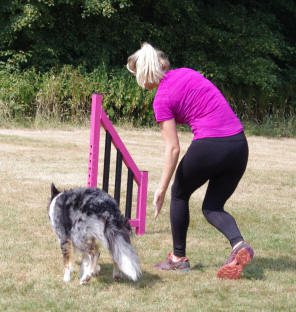
Send the dog round the wing in a clockwise direction.
|
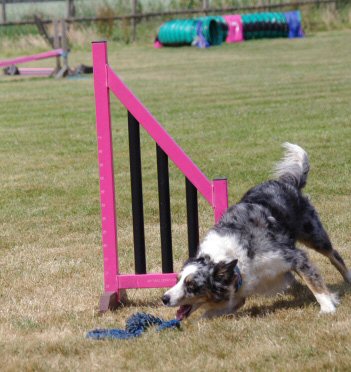
Place the reward at the wing for the dog to find
as he completes his wing wrap. 3 |
You are now ready to introduce the toy as a reward, which will increase
speed. Remember to reward from your right hand for anti-clockwise wraps as you
complete the front cross so you are not luring the dog around the wing with his
toy.
For this game, it works best if you work on both sides – left and right – in
the first session. This keeps it even in terms of the dog’s physicality, and
ensures that he does not favour one side over another.
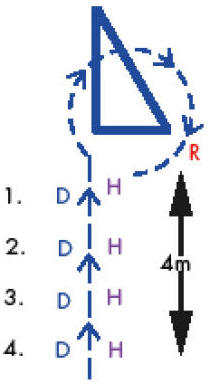 At a distance At a distance
You are now ready to increase the distance you are sending your dog
to wrap around the wing. Do this gradually so your dog learns to find the wing
independently.
 How
to play How
to play
The handler sets up the dog on the left side, half a metre (less
than 2ft) from the jump wing.
Using the left drive arm, and the verbal cue "check", the handler
sends the dog to the wing and starts to rotate to the left.
- As soon as the dog has completed the wrap, the handler picks him up on
the right and throws the toy to reward him at the wing.
- The handler can increase the distance from the jump wing by half a metre
each time the dog completes the move successfully.
- To assist learning, the handler can take one step in with the left leg
to mark the obstacle, and use the left drive arm.
- Turn the wing around, and repeat. This time the dog is on the right
side. The handler uses the right drive arm, picks up on the left and rewards
at the wing.
Do not be in too much of a hurry to increase distance. You want your dog to
be confident and successful as he works away from you. This will pay great
dividends later on when you are on an agility course.
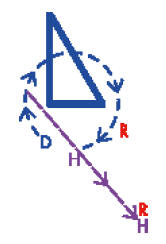 Moving off Moving off
This game teaches your dog to commit to the wing even though you are
moving off. This is invaluable as it means you can leave your dog to complete a
tight turn while you head off to the next obstacle on the course.
 How
to play How
to play
Starting with the dog (D) on the left side, the handler (H) sends
him to the wing, with the verbal cue "check".
As the dog heads off, the handler rotates to the left, and completes
the turn before running off to pick up the dog on the right, and giving
the reward (R).
- The handler can mix up the reward, sometimes rewarding from the hand,
and sometimes throwing it back for the dog to pick up as he comes in on the
right side.
- Repeat on the other side. The handler uses the right drive arm, picks up
on the left and rewards at the wing.
WHAT IF... your dog is distracted by your movement and wants to follow you
rather than complete his wing wrap?
Decrease the distance you are moving off.
Slow your pace – to a walk if necessary – until your dog gains a fuller
understanding.
Making it harder
Imagine a clock face and place the jump wing in the centre.
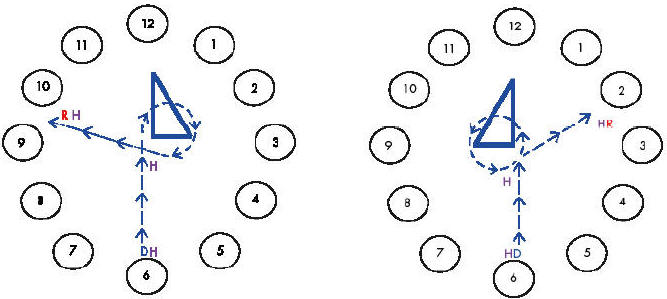
 How
to play How
to play
The handler (H) stands at 6 o’clock, with the dog (D) on the left,
and sends the dog to the wing, with the verbal cue "check".
As the dog heads for the wing, the handler heads for the gap between
9 o’clock and 10 o’clock and gives the reward (R) from the right hand.
Repeat on the other side. The handler (H) stands at 6 o’clock, with
the dog (D) on the right side.
The handler sends the dog and heads for the gap between 2 o’clock
and 3 o’clock and gives the reward (R) from the left hand.
Remember to vary the reward, sometimes rewarding back at the wing to
give it value.
|
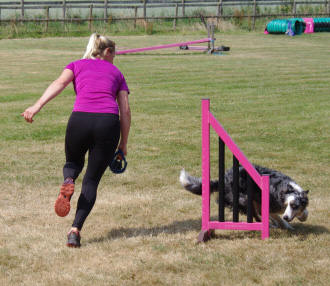
When the
dog fully understands his job you can leave him to wrap the wing
while you run off to the next handling point. |
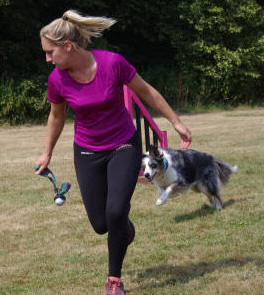
Note the acceleration as the dog completes a clockwise
wing wrap
and drives to the handler – and his reward. |

Foundation Fun & Games is available from
Performance Dog
-
Size:
210mmA x 168mm
-
Extent: 176 pages
-
Binding: Softback with flaps
-
Over 100 photos and diagrams
-
Bonus section of courses
-
Price: £16.99 - post free
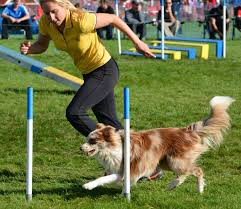 About
the author... About
the author...
Connie Sellers is an agility instructor, a Grade 7 and a Crufts and
Olympia finalist. She teaches students at all levels, but especially enjoys
working with new partnerships, young dogs and their handlers to get
started in their agility careers.
First published 27th
August 2019
| |
|
 At a distance
At a distance Moving off
Moving off
 About
the author...
About
the author...